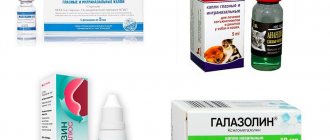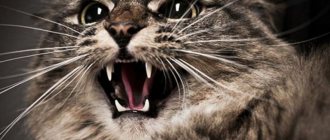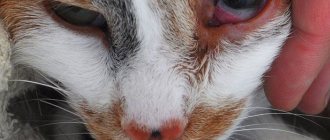How to treat
Ear mites, also known as otodectosis, are treated in different ways. Among the known methods, the following methods of struggle can be distinguished:
- insecticidal spray, and if ticks have spread to the body - drops on the withers;
- ear cleaner;
- drops;
- ointment.
If the choice is between drops or spray, then it is better to choose a spray. It can be used to treat not only a cat’s dirty ears, but also the animal’s main place of residence, for example, a box. If we talk about choosing a drug, then preference is given to such means as:
- Dermatosol.
- Psoroptol.
- Fipronil.
- Cyodrine.
In fact, the range of sprays against skin parasites is quite large. Therefore, the store will offer you something. There are no special priorities in this regard.
The main thing here is not to confuse ear mites with another disease. For example, a yeast infection in a cat’s ears produces similar symptoms – dark discharge (exudate). And the incorrect use of drugs against otodectosis can easily worsen the situation. For this reason, if you are unsure about something, go to the vet.
When to contact a veterinarian
It is recommended to visit the veterinarian regularly, performing a preventive examination every six months. This will help to identify diseases in the early stages of development, when it is possible to cure the animal more easily and quickly, without exposing the body to serious danger, surgery or exposure to potent medications.
Here are a number of reasons for an urgent unscheduled visit to the veterinary clinic:
- uncharacteristic odor from the ears;
- a large amount of discharge that appears very quickly;
- refusal of active games;
- decreased appetite;
- general depression;
- lack of shine in the coat, which becomes ragged;
- the appearance of blood and pus;
- constant attempts to scratch in and around the ear.
If you notice dirt in the ears, it is best to take your cat to the doctor.
Other causes of dirty ears
Some cat breeds have large ears, which are natural dust collectors. But even in an ordinary ear, dust accumulates over time and settles in the auricle. If too much dirt accumulates, the animal’s internal defenses come into play. This consists in increased secretion of earwax and, as a result, the formation of a dirty mass.
In some cases, the intensity of the work of the cerumen gland does not depend on external stimuli, so dirty ears can occur in cats that are constantly in a clean house. Most often, this phenomenon affects breeds that have no or little hair on their ears, but this is the animal’s natural protection from external influences. These ears need to be cleaned regularly.
Methods of care and prevention
First of all, you need to regularly check your pet's ears and clean them periodically. At the first sign of a change in plaque in the ears, consult a specialist.
It is best to arrange preventive visits even before signs of pathology appear. It is worth noting that self-medication in cases of hearing loss in most cases leads to a worsening of the situation, even if this does not manifest itself immediately. Inflammatory processes can continue even after the visible symptoms of the disease have disappeared. And prolonged inflammation can lead not only to deafness, but also to death.
To prevent ear mite infestation, you should limit your cat's contact with outdoor animals. This is not easy to do if your pet is used to walking on his own, but try to make sure he distances himself from potential danger.
You can also use prophylactic drops for the withers, which prevent infection with infectious diseases, as well as treating the ear canals with a special composition. Such products are easy to find in a veterinary pharmacy, and they can be used on a kitten or a pregnant cat.
How to properly scrub a cat's ears
The procedure for cleaning a pet's ears is a rather complicated task that requires compliance with certain rules. In (types of manipulation, you need to prepare the necessary material:
- Cotton swabs or tampons.
- Hydrogen peroxide syrup, but you can use a special gel.
- Lention for fixing the animal.
In principle, this arsenal of aids is amba for cleaning the ears. After you have prepared all of the above, you should do the following:
- Place the animal on a chair, securing it tightly with a towel.
- Hold the edge of your ear with your finger.
- Carefully examine the inner ear cavity of the animal.
- If you find deposits of dirt from the outside, carefully remove them using a peroxide-soaked swab.
- Then pour in a few drops of the drug prescribed by the veterinarian.
- You can sit for a while so that the liquid is evenly distributed; for this purpose, you can lightly massage the ear at the base.
- After this, you can carefully remove the dirt with a cotton swab.
- At the end of the procedure, use a cotton pad to blot off any remaining liquid.
For your cat's long-suffering and endurance, after cleaning its ears, it is worth giving it its favorite treat.
Important point: You should not benefit from any ear drops on your own without a doctor’s prescription.
How to clean your child's ears yourself?
Before you begin the cleaning process, stock up on the necessary supplies:
- Cotton swabs – 3-4 pcs. per ear canal.
- Towel – for fixing the animal during the procedure.
- A special cleaning gel will help to act as delicately as possible on the ear canal.
If you need to clean your cat's very dirty ears, use the following scheme:
- Gently twist and bend the cat's ear. Dip a cotton swab into the gel and begin to process the passage;
- Do not insert the stick completely into the auricle, but move it literally 1 cm;
- Try to move the stick from the middle and outward, and not inward. Otherwise, you'll just be pushing more sulfur into the middle.
Before starting the procedure, try to secure your pet with a towel so that it does not run away and cannot scratch you. Perform all movements slowly and as carefully as possible. During the cleaning process, do not be afraid that you will pierce the eardrum with a stick, since you will not be able to reach it (if you do not insert the object as deeply as possible).
Treatment
Therapy depends on the diagnosis. Treatment must be comprehensive and includes hygiene procedures, medications, diet, and is carried out in three stages:
- Cleaning the ear canals.
- Taking medications prescribed by a veterinarian.
- Strengthening the immune system.
Hygiene procedures begin with cleaning the ear canal. For this purpose, special lotions are used that have anti-inflammatory and antiseptic effects.
The product is dripped into the ear and lightly massaged. Contaminants come out with excess liquid. Then gently wipe the skin with a cotton pad.
At this moment, the cat may shake its head and twitch its ear - this is a normal reaction. In this way, he gets rid of the fluid that bothers him, and the auricle is cleansed.
Medications
Drops are used to treat otitis media. They have antibacterial, anti-inflammatory and analgesic effects.
Drops aimed at treating otitis media in cats:
- Surolan . Antimicrobial and antifungal drug. Place 3-5 drops into each passage. Before use, a hygienic procedure is carried out to clean the passages. The course of treatment is no more than 2 weeks.
- Aurikan . Combined product for pets. Cats weighing up to 1.5 kg are prescribed 5 drops once a day. The course of treatment is no more than 7 days.
Most drops are suitable for getting rid of ear mites, as they have a wide range of effects. During the treatment period, special attention is paid to the cleanliness of the ear canal. Hydrogen peroxide is used for rinsing.
In case of allergic reactions, antihistamines for animals are used . In addition to therapy, it is recommended to eliminate allergens and follow a diet.
Antihistamines:
- Suprastin;
- Diazolin;
- Tavegil;
- Fenistil.
Tablets or drops are given to the pet 2 times a day. Only a veterinarian can prescribe the drug. You cannot self-medicate your cat.
To boost the immune system use:
- Salmozan;
- Glycopene;
- Gamaprene.
The drugs strengthen the pet’s immunity and supply the body with vitamins. This allows you to avoid the development of fungal infections, colds, and otitis media.
In case of head injury, therapy is carried out in a hospital under the supervision of specialists and is aimed at restoring the central nervous system and brain.
Traditional methods
Traditional methods are used in combination with drug treatment and in cases where it is not possible to consult a veterinarian.
Folk remedies:
- To cleanse the ear canal, green tea is used, which is dripped into the ear canal. After this, the auricle is lubricated with almond or lavender oil and a light massage is given.
- Instill chamomile decoction. It cleans the passage and relieves inflammation. Then drop in mint oil diluted with water in a 1:1 ratio. It has a bactericidal effect.
- Garlic and oil ointment. To prepare, take 1 tbsp. l. vegetable oil and 1 g of chopped garlic, mix thoroughly. Lubricate the ear once a day. The ointment has an antiseptic effect.
- Geranium juice is used against otitis media. The fresh leaf is ground into a paste and the juice is squeezed out. Using a pipette, drop 1 drop into each ear.
If itching and redness occurs, treatment should be stopped.
Prevention
To prevent odor from appearing in your animal’s ears, you need to monitor your pet’s health and diet. Hygiene procedures are carried out once a month, this is especially important for fold-eared breeds.
Cleaning procedure:
- Wrap the animal in a towel to avoid scratches.
- Moisten a cotton swab with lotion or hydrogen peroxide.
- Gently clean the ear canal.
- Wipe the inner surface with a dry cotton pad.
It is necessary to monitor the diet of cats prone to allergies. Food should be balanced . If the animal eats from the “common table”, fatty meat, cheese, and smoked products are excluded. The best solution would be to switch to hypoallergenic dry and wet food.
For preventative purposes, the pet is shown to a veterinarian every 6 months. This allows you to eliminate any diseases that cause unpleasant odors from the ear canal.
You should not leave your cat in a draft - this provokes the development of otitis media. Walking outside is only possible in warm weather.
Formation of sulfur plugs
If your cat belongs to a breed with a unique ear structure, for example, Sphynx, then most likely the cause of dirt inside the ears is considered to be wax plug. It’s just that such pets often produce sulfur. It accumulates, and various microbes develop in it.
The sulfur plugs themselves, although they cause discomfort to the pet, are dangerous. True, sometimes they can lead to an inflammatory process.
IMPORTANT! The main way to treat traffic jams at home is to use a medicated lotion.
After applying the medicine, it dissolves. If this still does not help, then consult a doctor.
What to do if your cat has black dirt in his ear and itches
The main reasons for the accumulation of large amounts of dirt and wax in the ears of cats, as well as the discharge of pus, are such cat diseases as:
- Otodectosis, caused by ear mites. Constantly dirty ears of a cat become a provocateur for these parasites to attach to the outer ear canal and live there comfortably, feeding on the epidermis. As a result, fluid begins to ooze from the damaged areas of the ear. After drying, it turns into a dirty crust. Ticks can appear in a cat from contact with other animals that carry ticks.
- Otitis - can occur due to a head injury or infection. As a result of this disease, a sick animal secretes wax with pus, sometimes even blood, in the ear area.
- Allergic susceptibility.
- Infectious diseases of fungal, yeast and bacterial nature.
Otodectosis
- Otodectosis, or ear mite. The microscopic parasite penetrates the pet’s body through contact with a sick animal or its bedding and other household items. A person can also bring a tick into the house on their clothing or shoes. Penetrating into the auricle, the arthropod begins to feed on the epithelium, damaging the ear tissue. As a result of its vital activity, small wounds form on the upper integuments, from which liquid oozes, forming a dirty coating. Over time, the tick penetrates deeper, and bacteria begin to multiply in the resulting skin lesions.
Cat ears with ear mites
- Otitis. Develops as a result of infection of the auricle. The inflammatory process is provoked by: hypothermia, penetration of water into the ear, streptococci and staphylococci, microscopic injuries. Otitis develops in animals with low local or general immunity.
- Sulfur plug. Formed in a kitten or cat prone to increased sulfur secretion. This property is typical for sphinxes. In representatives of other breeds, wax plugs may appear due to lack of ear care, after severe stress, in the hot season.
Cat food allergy to food
- Allergies. One of the manifestations of an allergic reaction is the appearance of itching. Dark plaque on the ears appears due to the fact that the pet scratched the ear.
Black plaque in a cat's ear
- Fungus. Fungal spores do not often enter the ears of pets. However, when a cat occasionally visits the street, it can become infected through contact with a sick animal.
- Necrosis. It develops if, after an injury to the hearing organ, there is no treatment or an infection enters the wound.
Treatment is prescribed based on the diagnosis and accompanying symptoms. Before starting treatment procedures, the cat’s ears are cleaned of discharge. Use cotton swabs for cleaning. The plaque is first softened with Vaseline oil. It is necessary to remove accumulations formed on the surface of the ear, and discharge located at a depth of 1 cm in the auricle. Basic methods of treating cats at home.
Ear sanitation
| Disease | Main method of treatment | Additional events |
| Otodectosis |
| If an infection is added to the underlying pathology, the cat is prescribed antibiotics. |
| Otitis |
| Cleaning the ears with hydrogen peroxide, adding vitamin and mineral complexes to food. |
| Sulfur plug | If there is no infection, no specific treatment is required. | Softening sulfur plugs with hydrogen peroxide. Keeping your ears clean. |
| Allergy |
| In difficult cases, steroids are used. During treatment, the pet’s diet is strictly monitored. |
| Fungus |
| The use of antiallergic drugs that reduce the symptom of itching and painkillers. |
| Necrosis |
| Balanced diet, vitamins and minerals. |
The body of any living creature has unique characteristics. The appearance of dirt in the ear canals of a completely healthy cat is, for the most part, not a cause for concern. But sometimes this indicator means that the animal has a dangerous disease or that the inflammatory process of the hearing organ is rapidly developing. In normal condition, the inner part of a cat's ears has a light pinkish tint.
It makes sense to pay attention to this especially if the cat constantly shakes its head and scratches nearby ears. In such a case, you cannot do without the help of a veterinarian, since only a specialist is able to establish the true cause of the animal’s illness and determine the best option for dealing with the problem.
In some cases, accumulations of dirt, serous discharge, or pyothorax have appeared in the ears of a domestic cat; such pathological phenomena can be explained by the following factors:
- The development of otodectosis is a pathology, the arrival of which is most often provoked by ear mites. These parasitic microorganisms are firmly attached to the outside of the ear canal. Conforming to the fact that the main food of mites is skin, the skin inside the auricle is damaged, and liquid contents are released from the wounds. This secretion turns into mud when it dries. But the most important thing is that a healthy cat can become infected with a tick upon contact with a sick animal. These small parasites live even on the skin of human hands, and they are also not prohibited from being found on his clothes.
- During the course of otitis, one or the other most often develops as a result of infection. But this disease can be a consequence of an animal’s head injury. It is advisable to treat otitis media only after examining the animal by a veterinarian.
- An allergic manifestation to food or an external provoking factor.
- Infectious processes caused by fungi or other pathogenic microorganisms.
- Large animal ears. There are some cat breeds that are distinguished by their impressive ear sizes. Caste anatomical feature contributes to the accumulation of dust. When large amounts of dirt accumulate, the sulfur chamber intensifies. All these phenomena lead to significant contamination of the cat's ears.
- Wool deficiency. This feature is also observed in certain breeds of cats. As an example, it is allowed to cite the sphinxes. In cats of this breed, the ears are essentially devoid of hair, which makes the animal's hearing organ defenseless from any external negative influence. Pets of hairless breeds need to clean their ears with increased care.
We suggest you read: How to take a cat's temperature











